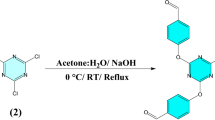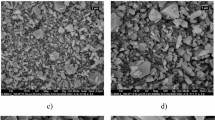Abstract
A novel nitrogen-rich covalent organic polymer was synthesized through a green synthetic approach by reacting 4,4'-diaminodiphenylsulfone and 4,4',4''-((1,3,5-triazine-2,4,6-triyl)tris(azanediyl))tribenzoic acid. The reaction was conducted under environmentally friendly conditions, utilizing tetra butyl ammonium bromide as a green solvent and triphenyl phosphite as a catalyst. The structure and morphology of the synthesized adsorbent were recognized using TGA, BET, XRD, FT-IR, EDX-Mapping, and FE-SEM analyses. Following characterization, the synthesized adsorbent was employed for the purpose of methylene blue (MB) dye removal. Multiple parameters, including pH, time duration, and initial concentration, were systematically assessed and analyzed. Based on isotherm models, Langmuir was fitted suitably to the experimental data of MB with maximum adsorption of 384.6 mg g−1 at pH 10 in 40 min. After examining the linear regression coefficients (R2), it was determined that the pseudo-second-order model provided a good fit for adsorbing MB.







Similar content being viewed by others
References
Aliabadi HM, Zargoosh K, Afshari M, Dinari M, Maleki MH (2021) Synthesis of a luminescent g-C3N4–WO3–Bi2WO6/SrAl2O4:Eu2+, Dy3+ nanocomposite as a double z-scheme sunlight activable photocatalyst. New J Chem 45:4843–4853
Alencar LV, Passos LM, Soares CM, Lima AS, Souza RL (2020) Efficiency method for methylene blue recovery using aqueous two-phase systems based on cholinium-ionic liquids. CTFTTE 6:13–20
Ahmad A, Mohd-Setapar SH, Chuong CS, Khatoon A, Wani WA, Kumar R, Rafatullah M (2015) Recent advances in new generation dye removal technologies: novel search for approaches to reprocess wastewater. RSC Adv 5:30801–30818
Sheng L, Zhang Y, Tang F, Liu S (2018) Mesoporous/microporous silica materials: preparation from natural sands and highly efficient fixed-bed adsorption of methylene blue in wastewater. Microporous Mesoporous Mater 257:9–18
Pandey S, Do JY, Kim J, Kang M (2020) Fast and highly efficient removal of dye from aqueous solution using natural locust bean gum based hydrogels as adsorbent. Int J Biol Macromol 143:60–75
Fong W, Affam A, Chung W (2020) Synthesis of Ag/Fe/CAC for colour and COD removal from methylene blue dye wastewater. Int J Environ Sci Technol 17:3485–3494
Pang Y, Tong Z-H, Tang L, Liu Y-N, Luo K (2018) Effect of humic acid on the degradation of methylene blue by peroxymonosulfate. Open Chem 16:401–406
Sun L, Hu D, Zhang Z, Deng X (2019) Oxidative degradation of methylene blue via PDS-based advanced oxidation process using natural pyrite. Int J Environ Res Public Health 16:4773
Rahmanian O, Maleki MH, Dinari M (2017) Ultrasonically assisted solvothermal synthesis of novel Ni/Al layered double hydroxide for capturing of Cd (II) from contaminated water. J Phys Chem Solids 110:195–201
Dinari M, Shirani MA, Maleki MH, Tabatabaeian R (2020) Green cross-linked bionanocomposite of magnetic layered double hydroxide/guar gum polymer as an efficient adsorbent of Cr (VI) from aqueous solution. Carbohyd Polym 236:116070
Dinari M, Maleki MH, Bagheri R (2019) Synthesis and characterization of new nitrogen-and oxygen-rich cyclohexanone–formaldehyde resin for fast Cd (II) adsorption in aqueous solution. Polym Int 68:1636–1644
Fu X, Chen X, Wang J, Liu J (2011) Fabrication of carboxylic functionalized superparamagnetic mesoporous silica microspheres and their application for removal basic dye pollutants from water. Microporous Mesoporous Mater 139:8–15
Ghoreishi S, Haghighi R (2003) Chemical catalytic reaction and biological oxidation for treatment of non-biodegradable textile effluent. Chem Eng J 95:163–169
Santiago AA, Ibarra-Palos A, Cruz-Morales JA, Sierra JM, Abatal M, Alfonso I, Vargas J (2017) Synthesis, characterization, and heavy metal adsorption properties of sulfonated aromatic polyamides. High Perform Polym 30:591–601
Higashi F, Nishi T (1986) Direct polyamidation with thionyl chloride in N-methyl-pyrrolidone. J Polym Sci Part A Polym Chem 24:701–706
Dinari M, Haghighi A (2017) Synthesis and characterization of new heat-resistant polyamides bearing an s-triazine ring under green conditions. J Polym Res 24:1–9
Dinari M, Fardmanesh K, Maleki MH, Asadi P (2022) Synthesis, characterization and antimicrobial properties of new L-cysteine based chiral aromatic polyamides. Polym Bull 79:11103–11117
Dutta S, Gupta B, Srivastava SK, Gupta AK (2021) Recent advances on the removal of dyes from wastewater using various adsorbents: a critical review. Mater Adv 2(14):4497–4531
Wang B, Zhang Q, Xiong G, Ding F, He Y, Ren B, You L, Fan X, Hardacre C, Sun Y (2019) Bakelite-type anionic microporous organic polymers with high capacity for selective adsorption of cationic dyes from water. Chem Eng J 366:404–414
Zhu X, An S, Liu Y, Hu J, Liu H, Tian C, Dai S, Yang X, Wang H, Abney CW (2017) Efficient removal of organic dye pollutants using covalent organic frameworks. AIChE J 63:3470–3478
Huang L, He M, Chen B, Hu B (2018) Magnetic Zr-MOFs nanocomposites for rapid removal of heavy metal ions and dyes from water. Chemosphere 199:435–444
Dinari M, Nabiyan A, Ensafi AA, Jafari-Asl M (2015) Polybenzimidazole and polybenzimidazole/MoS 2 hybrids as an active nitrogen sites: hydrogen generation application. RSC Adv 5:100996–101005
Mallakpour S, Zadehnazari A (2013) The production of functionalized multiwall carbon nanotube/amino acid-based poly (amide–imide) composites containing a pendant dopamine moiety. Carbon 56:27–37
Kithome M (1998) Reducing nitrogen losses during composting of poultry manure using the natural zeolite clinoptilolite. University of British Columbia
Tahir S, Rauf N (2006) Removal of a cationic dye from aqueous solutions by adsorption onto bentonite clay. Chemosphere 63:1842–1848
Haque E, Jun JW, Jhung SH (2011) Adsorptive removal of methyl orange and methylene blue from aqueous solution with a metal-organic framework material, iron terephthalate (MOF-235). J Hazard Mater 185:507–511
He Y, Xu T, Hu J, Peng C, Yang Q, Wang H, Liu H (2017) Amine functionalized 3D porous organic polymer as an effective adsorbent for removing organic dyes and solvents. RSC Adv 7:30500–30505
Taşdelen B, Çifçi Dİ, Meriç S (2017) Preparation of N-isopropylacrylamide/itaconic acid/Pumice highly swollen composite hydrogels to explore their removal capacity of methylene blue. Colloids Surf A 519:245–253
Ma D, Zhu B, Cao B, Wang J, Zhang J (2017) Fabrication of the novel hydrogel based on waste corn stalk for removal of methylene blue dye from aqueous solution. Appl Surf Sci 422:944–952
Kuang Y, Zhang X, Zhou S (2020) Adsorption of methylene blue in water onto activated carbon by surfactant modification. Water 12:587
Rahmanian O, Falsafin M, Dinari M (2020) High surface area benzimidazole based porous covalent organic framework for removal of methylene blue from aqueous solutions. Polym Int 69:712–718
Acknowledgements
The authors would like to sincerely acknowledge the cooperation and resources made available to us by the Isfahan University of Technology, IRAN and the Iranian National Science Foundation (INSF) for their financial (Grant No. 4026090) support.
Author information
Authors and Affiliations
Corresponding author
Ethics declarations
Conflict of interests
The authors declare no competing financial or nonfinancial interests that are directly or indirectly related to this work.
Additional information
Publisher's Note
Springer Nature remains neutral with regard to jurisdictional claims in published maps and institutional affiliations.
Rights and permissions
Springer Nature or its licensor (e.g. a society or other partner) holds exclusive rights to this article under a publishing agreement with the author(s) or other rightsholder(s); author self-archiving of the accepted manuscript version of this article is solely governed by the terms of such publishing agreement and applicable law.
About this article
Cite this article
Arameshian, S., Dinari, M. & Rezaei, F. Green synthesis of novel nitrogen-rich covalent organic polymer for efficient removal of methylene blue from aqueous solutions. J Polym Res 31, 97 (2024). https://doi.org/10.1007/s10965-024-03943-3
Received:
Accepted:
Published:
DOI: https://doi.org/10.1007/s10965-024-03943-3




